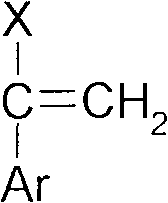Continuous bulk polymerization process for preparing extruded acrylonitrile-butadiene-styrene graft copolymer
An extrusion grade, styrene technology, applied in the field of polymer preparation, can solve problems such as difficult to meet food grade requirements, poor appearance, unpleasant smell, etc.
- Summary
- Abstract
- Description
- Claims
- Application Information
AI Technical Summary
Problems solved by technology
Method used
Image
Examples
Embodiment 1
[0106] The reaction system of this example employs four reactors in series. This embodiment adopts the mode that all materials are added to the first reactor. First add 20kg of ethylbenzene and 48.95kg of styrene to the rubber dissolving tank, start stirring, and then cut 10kg into 10×10mm Asahi Asaprene TM Add 730AX rubber into the rubber dissolving tank through the glue inlet, stir and dissolve at room temperature for 10 hours to obtain a rubber solution mixture. Then add 19.04kg of acrylonitrile to it, then add 1.37kg of white oil, 0.0294kg of antioxidant 3,5-tert-butyl-4-hydroxyl-phenyl-octadecyl ester, 0.029kg of chain transfer agent dimerized a-methanol Base styrene, 0.0147kg initiator tert-butyl perbenzoate, and then continue to stir and disperse for 30min.
[0107] The feed rate of the reactor is 1540mL / h; the pressure of the whole system is controlled at 0.9±0.2MPa; the reaction temperature of the four reactors is sequentially controlled at 100°C; 106°C; 125°C; 145°...
Embodiment 2
[0113] The reaction system of this embodiment still uses four reactors in series. This embodiment adopts the mode that all materials are added to the first reactor. Add 20kg of ethylbenzene and 48.95kg of styrene into the rubber dissolving tank, start stirring to cut Asahi Asaprene into 10*10mm TM 10kg of 730AX rubber is put into the rubber dissolving tank through the glue port, and stirred and dissolved at room temperature for 9 hours. Then add acrylonitrile 19.04kg, and 1.37kg white oil, 0.0294kg antioxidant 3,5-tert-butyl-4-hydroxyl-phenyl-octadecyl ester, 0.0392kg chain transfer agent dimerized a-methylbenzene Ethylene, 0.0147kg initiator tert-butyl perbenzoate, continue to stir and disperse for 30min.
[0114] The feed rate of the reactor is 1540mL / h; the system pressure is controlled at 0.9±0.2MPa; the reaction temperature of the four reactors is 101°C; 110°C; 130°C; 150°C; the stirring speed of the reactor is 100, 180, 30, 15 rpm; the volume of the reactor used is 3....
Embodiment 3
[0119] The reaction system of this example employs five reactors in series. In this embodiment, part of the material is added to the first reactor, and part of the material is passed through the fifth reactor (also called "grafting reactor") to obtain a certain degree of grafting and phase inversion, and then added to the subsequent third reactor The way. Add 19.8kg of ethylbenzene and 48.5kg of styrene to the rubber dissolving tank, start stirring, and put 9kg of Asahi AsapreneTM 730AX rubber cut into 10*10mm and 1kg of CB565 rubber into the rubber dissolving tank through the glue inlet, and stir and dissolve at room temperature for 11 hours. Then add acrylonitrile 18.5kg, 1.37kg white oil, 0.0294kg antioxidant 3,5-tert-butyl-4-hydroxyl-phenyl-octadecyl ester, 0.0368kg chain transfer agent dimerized α-methylstyrene , 0.0147kg initiator tert-butyl perbenzoate, continue to stir and disperse for 30min.
[0120] The main feed rate of the reactor is 1540mL / h; the system pressure...
PUM
| Property | Measurement | Unit |
|---|---|---|
| glass transition temperature | aaaaa | aaaaa |
| particle diameter | aaaaa | aaaaa |
| particle diameter | aaaaa | aaaaa |
Abstract
Description
Claims
Application Information
 Login to View More
Login to View More - R&D
- Intellectual Property
- Life Sciences
- Materials
- Tech Scout
- Unparalleled Data Quality
- Higher Quality Content
- 60% Fewer Hallucinations
Browse by: Latest US Patents, China's latest patents, Technical Efficacy Thesaurus, Application Domain, Technology Topic, Popular Technical Reports.
© 2025 PatSnap. All rights reserved.Legal|Privacy policy|Modern Slavery Act Transparency Statement|Sitemap|About US| Contact US: help@patsnap.com



